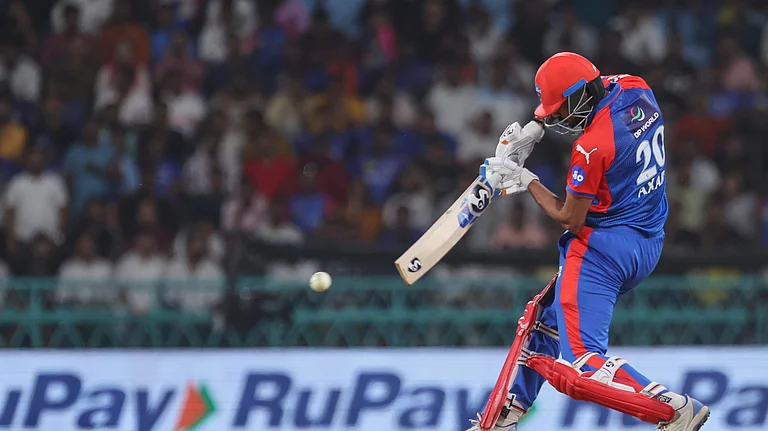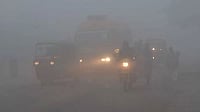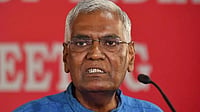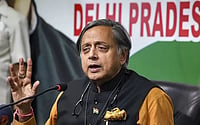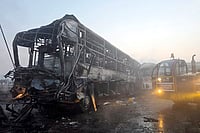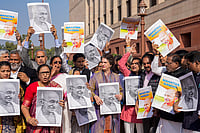A killer is on the prowl in the dense hilly forests of the Melghat region of Maharashtra's Amravati district. In the past four-and-a-half months, 336 tribal children have fallen prey to it. It's hunting for more. And it's no grisly animal thirsting for blood—but malnutrition killing weak, defenceless children.
Barely four years shy of the 21st century and just a four-hour drive from the thriving Nagpur township, each monsoon sees hundreds of starving children from the Korku tribe keep their date with an untimely death. Unofficial figures claim over 500 children have already died this year. And, over 25,000 malnourished children are crying out for help before they too become victims of this unfortunate and unfailing annual routine.
Though the Maharashtra Chief Minister Manohar Joshi on Friday ordered a high-level inquiry into the starvation deaths, the move might be too late to change the prevailing situation.
The sorry saga begins with the arrival of incessant rain that makes the already-meagre supply of food and safe drinking water even more scarce. In turn, playing havoc with young, decrepit immune systems which give in to diseases like diarrhoea, dysentery and pneumonia. Then, at hastily set-up health camps in the Chikhaldara and Dharni tehsils, which house the Korku villages, fragile frames and puny bodies with bloated stomachs line up on dirty hospital linen. Often to breathe their last.
So set has this pattern become that most locals consider these malnourishment deaths a seasonal phenomenon. An occurrence that is part of the difficult and deprived lifestyle of the Korkus who reside in inaccessible hamlets tucked away in the Satpura hills. "These are expected deaths," says N.D. Hantodkar, medical officer at the Chikhaldara Rural Hospital. "Look, there's nothing unusual about the rains killing Korku kids. The media shouldn't make such a song and dance about it."
Dishing out statistics to validate his stance, the medic informs that the month of July in 1993, 1994 and 1995 saw 67, 90and 40 children dying of malnourishment respectively. Pointing out that the corresponding figure for this year is "only" 57, the doctor makes no efforts to disguise the sarcasm in his tone: "The media seems to be agonising over these deaths much more than the Korkus themselves!"
Indeed, Korku parents can hardly afford the luxury of mourning the deaths of their children. With no avenues of employment, no food in their slushy huts and disease breeding in their wells, Korku life is still primitive in its struggles and stoic in its sorrows. "This is our lot. Less food makes children die. But, then, God gives more children to compensate," philosophises Padial Bhumka, pradhan of Lawada village. Then, pointing to a fragile 21-year-old pregnant woman, the old man clucks his disapproval of the Almighty: "But God is not kind to Buli and women like her."
And as eyes turn towards her, Buli remains expressionless despite this sudden scrutiny. She clutches on to her severely malnourished daughter Jhunni as her three older children hover in the background. Her husband died (vomiting) last month, she says without a trace of grief on her face. "Men here keep dying of ulti . My daughter will die of loose motion," she observes. But mention food and Buli frowns. Food means future in the Korku mind. "There's very little food....Times ahead will be more difficult. I might have to lose my next child too," she explains, "and I have no husband to give me more children or bring in food."
Buli voices the basic beliefs that emanate from the almost primal life cycle that is the lot of the Korku tribals—marriage at the early age of 14 or 15 followed by the birth of many children to provide more hands to help in the family's quest for food. There is little else in life. Certainly no education to infuse new desires. "Some children die. Others are born," says Shitu from Tarkandar village as she nurses two of her four children at the Semadoh Primary Health Centre. Almost dispassionately, Shitu recalls her son who died of the same 'loose motion' in the last rainy season. "I don't know why these doctors insist we remain here in these nasty hospitals," she says. "The very thin children always die anyway. With or without doctors."
More often without doctors. Says the health centre's Dr S.B. Tawar: "Two reasons contribute to the lack of medical help provided to tribals. First, many Korku settlements are remote and difficult to access. Especially during the monsoons. Second, Korkus hate doctors and medicines and don't want to bring their children here."
The doctor confesses the use of police force at times to bulldoze Korku parents into hospitals: "Sometimes when they want to abscond with a dying child I am forced to call in the security chaps. I feel really bad about encroaching on the parent's right to choose for his child, but then I convince myself that my duty as a doctor demands such harshness." Paediatrician N. Sadhwani, on deputation at the Dharni health centre in the wake of the malnourishment deaths, is frustrated that doctors in the area end up spending less time treating a child and more time convincing parents to get their child treated.
Young and headstrong parents like Dhowdi villager Patil resent being retained 'forcefully' in hospitals. His eight-month-old son has been put on drip but Patil complains that the bhagat (sorcerer) in his village could have cured his child. "But the anganwadi didi in our village insisted that we come here. Well, we've been here for four days and the child is still as sick. There is no one to take care of the other children at home. But these people are not even letting us return," he says.
This aversion to medicine and modernity, however, is a manifestation of a deeper problem that needs to be addressed. Fifty years of independence should have cured the Korkus of the ignorance and illiteracy that gives rise to such ailing 'attitudes'.
"But who wants to be bothered about changing adivasi attitudes? No one even remembers them till they start dying in huge numbers. Then, political points are scored by the same Opposition leaders who did nothing to improve things during their stint in the government. The press gets active and some reporters come in to ask the same questions all over again," fulminates Neerupama Deshpande, a young post-graduate from Tata Institute of Social Sciences who, along with her husband, has chosen to settle down with the Korkus of Lawada. Their mud hut heaped with bamboo, the young social-worker couple teach the tribals to make cane articles to earn their livelihood. Neither the government khichdi that comes in as charity during the monsoon nor the alms of the bleeding heart NGOs help, reasons the fiery social worker. Her remedy: "Only employment and money will help them."
Well, then, the situation is pretty bleak. Currently, 569 tribals are earning a daily wage of Rs 23 under the government's Employment Guarantee Scheme (EGS). But the EGS has 15,359 tribals registered and looking for work. In projects that can accommodate only 1,114 of them. So what do the rest do? How do they ensure that their children don't starve? They look for employment as farm labourers and spend the entire day outside the house to earn paltry sums of money. Or, work in their soyabean farms and undersell the crop before harvest time in their financial desperation. At any rate, both parents are forced to work and leave malnourished toddlers in the care of young siblings who can hardly be expected to nurse them back to health.
Amravati's District Health Officer G.K. Yadav laments that no one recognises the fact that the malnourishment deaths are not just a health issue. "It's easy to swoop down here and point fingers at the faulty health system and inefficient doctors. But a fair assessment will show that this problem needs preventive cure at the social level rather than medicines and doctors."
State Health Minister Daulatrao Aher, however, seems confident that his visit to Amravati will help solve the problems: "Steps are already being taken. But to be more effective I need to know the extent of the problem. So, the chief minister and me are touring affected areas." Visits that might add to the load of the already-burdened administration.
Even as he prepares for VIP visits, the flustered collector of Amravati district, Vijay Satbir Singh, plans an agenda which might tackle the issues of poverty, population, education, employment and health simultaneously. Says he: "Not an easy task at all but one that we are trying very hard to do."
Pointing out that since about 75 per cent of the district is forested and over 50 per cent of it under Project Tiger it doesn't make the administration's task any easier. He lists the practical problems he faces: "It would help to have roads built—to provide better access to the tribals so as to monitor their health even more closely, as also to provide them with employment in road construction. But the Wildlife Protection Act prohibits us from doing that."
Voicing his fears, the bureaucrat indicates that past records show maximum deaths occurring in September. By then conditions worsen and existing ailments aggravate and many more children succumb. Official estimates predict that the death toll this year might go up to 600. Says Singh: "We are trying our best to deal with the problem. But the worst might still not be over."
Dead right. Nothing short of a many-pronged attack will slay the beast of starvation and death. Firefighting will just about shoo away the lurking danger—but only temporarily. To hibernate. Till the next monsoon.







